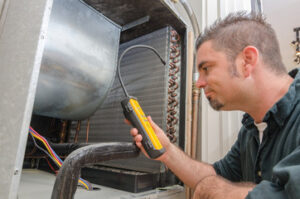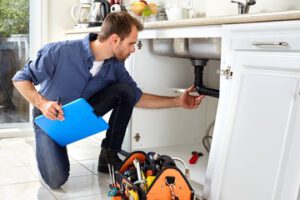Leak detection protects homes from one of the most expensive and damaging damages to houses. It also helps to save money on water bills and alerts to potential issues.
To check for a leak, shut off all the faucets and check the water meter. If the meter changes, there’s likely a leak somewhere in the house. Visit https://www.leakops.com/ to learn more.
Acoustic leak detection is a non-invasive technique that eliminates the need to dig up pipes or damage structures to check the physical characteristics and health of a water pipeline system. It is also much faster and more accurate than digging or trial-and-error methods of locating leaks.
This method of detecting leaks works by listening for the faint sounds emitted from a leak. The sounds that a leak produces are different from the sound of regular flow, and this difference is picked up by sensors on a water pipe. The sensors are then able to pinpoint the location of the leak. Acoustic leak detection is ideal for underground plumbing, as it can be used in locations that are hard to reach and does not require any excavation or destruction of the ground or surrounding structures.
The sounds emitted by leaks travel through the soil in different ways, depending on the type and diameter of the pipe. Iron mains and copper services emit sounds that can be heard up to 300 feet away, while steel and asbestos-cement pipes do not transmit sound as far. This is why it’s important to know the type of pipes you have in your area.
Leak detection is a valuable tool in reducing water loss, and it can help prevent costly repairs caused by water damage. It can also help reduce energy bills by preventing wasteful water use. On average, American households waste 10,000 gallons of water every year due to plumbing leaks.
Acoustic leak detectors can be used to locate and repair these small leaks before they cause significant damage. They can save homeowners thousands of dollars in water repair costs and lower their energy bills by ensuring that they are not wasting unnecessary water. They can also prevent sewage from flowing into the home, which can be very expensive and hazardous to the health of residents.
A plumbing leak is one of the most common causes of water damage in homes. It can result in costly repairs, mold growth, and structural damage. Acoustic leak detection can help homeowners and businesses find these hidden leaks quickly and easily, saving them money on water damage, energy bills, and potential repairs. The technology is very simple to use and can be installed on any home or business.
LiDAR
LiDAR (Light detection and ranging) uses a laser to measure the surface of an object or area. The data collected by this method provides a precise and detailed map of the surface. This technology is useful in identifying abnormalities such as surface degradation, slope changes, and vegetation growth. In addition, it can be used to monitor progress on projects such as highways, railways, and dams.
LiDAR sensors are capable of measuring the surface of the earth with great accuracy. They are often mounted on planes to gather data over large areas in a relatively short amount of time. Alternatively, they can be used on mobile platforms to collect data in urban areas or other difficult-to-reach places. The data gathered by this technique is known as a digital elevation model or DEM.
To create a DEM, the data is first collected and then converted to a 3D point cloud. This point cloud contains all of the x, y and z coordinates of every point in the data set. Then the points are grouped according to their type – such as building, vegetation or bare ground. Then the heights of these groups are subtracted from each other to give the real height of the underlying surface.
The strength of each lidar return depends on the surface material that it reflects off of. For example, the intensity of a return is higher when it hits a tree than when it hits the ground. This is why it’s important to classify the return type after a scan is completed.
In forestry, terrestrial LiDAR can be used to conduct plot-level forest inventory, species identification from bark structure analysis and canopy cover assessment. It can also be used to assess gap fraction and estimate Leaf Area Index (LAI).
However, this technology has a number of limitations. For example, the cost of a LiDAR system can be prohibitive for small to medium-sized forests and for a variety of other applications. In addition, there is a high risk of false positives. This is because the data may contain a single tree that looks different from its surrounding neighbours, which could be caused by wind or snow.
Sonic Leak Detectors
The human ear can detect a wide range of sound waves, but ultrasonic ones, emitted when highly pressurized air or gas escapes through leaks, are outside of the spectrum that humans can hear. Sonic leak detectors are designed to hear these sounds, which can be a noisy rushing rush or a monotonous tone that changes as the position of the source is adjusted. These devices are handheld, battery powered and operate similarly to an audio-frequency meter: the user puts on a headset and points it toward suspected leaks. They are often highly directional and ignore ambient noise, so they can focus on the area in question without being drowned out by machinery or other sources of ultrasound.
The electronics inside a sonic leak detector convert the inaudible ultrasound signals into recognizable sounds and meter readings, which are then transmitted to a headset for the user to interpret. Some models are more complex than others, but they all start with a microphone that detects and amplifies the sound waves of escaping gas. These signals are then fed through a bandpass filter that rejects audible frequencies and converted to audio, which is then heterodyned (frequency-shifted) into a recognizable signal for the user’s headphones or speakers. The signals are also digitized for analysis, allowing users to see the results on a display screen.
In addition to picking up on escaped gas, some of these devices are equipped with sensors that can detect the sound of vibrations caused by a leak or the presence of an electrical discharge. Some are also able to detect the temperature of water in a pipe.
Depending on the model, some of these devices can even shut off the gas flow when it detects a leak, helping to prevent dangerous overflow and fires. The INFICON Whisper with Accessory Kit, for example, is an advanced ultrasonic leak detector that provides a range of features for HVAC, automotive and industrial professionals to identify and locate even the smallest air and gas leaks quickly. Its smart power pack offers the choice of going wireless with up to two years of operation on lithium AA batteries or running from the mains, which gives it a backup in case the power fails.
Video Leak Detectors
The most effective way to monitor leaks in residential plumbing is by installing a home plumbing system that includes a video leak detection camera. This device will be able to spot the source of your leak in minutes, giving you the opportunity to have it repaired before major damage occurs. This is especially important for homes with older pipes that could be susceptible to leaking or bursting.
These devices are able to locate the source of the leak by transmitting ultrasound waves upstream and downstream to detect irregular water patterns in your pipes. The system will then alert you via a smartphone app that displays your live plumbing usage data, allowing you to keep track of water usage and consumption. This will help you prevent your water bill from skyrocketing.
Many systems are also capable of detecting when your pipes are at risk of freezing. When this happens, the ice expands and can crack or burst the pipe. If your system detects this, it will sever the water connection until temperatures rise or the homeowner assesses the risk and turns the flow back on.
Other types of leak detection systems are geared towards industrial settings where hazardous materials are being transported and stored. These systems use a variety of sensors and methods to ensure that the equipment is functioning correctly and that there are no leaks in the process. This is critical for safety reasons and to protect the profits of the company.
In the medical profession, a variety of life saving substances are being carried in bags and other containers that must be leak proof. These are typically put through rigorous testing before being approved for use by the FDA. This type of leak detection technology can test catheters, dialysis machines, syringes, laparoscopic instruments and oxygen regulators to ensure they are working properly and are not leaking. Detection of these leaks is vital in order to avoid medical emergencies that can be caused by the loss or contamination of these lifesaving fluids.

